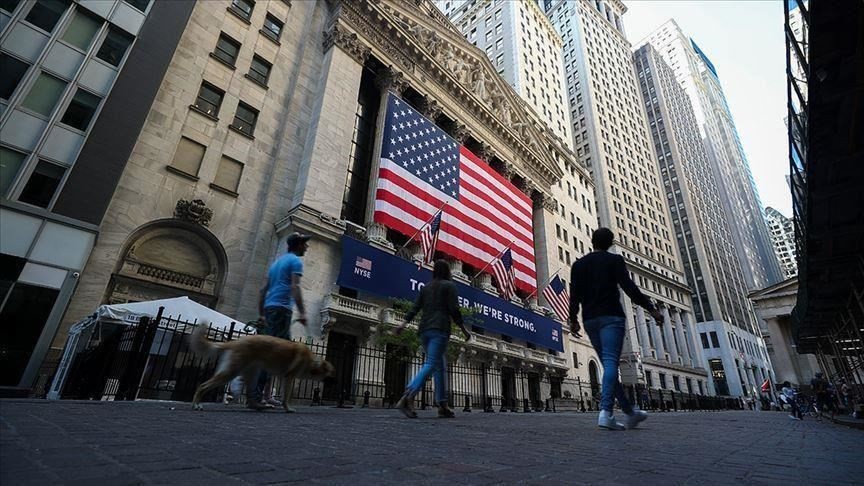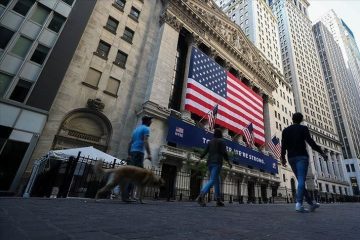Back Back Bond Selloff Threatens Hopes for Economy’s Soft Landing

A sudden surge in long-term interest rates to 16-year highs is threatening hopes for an economic soft landing, all the more because the exact triggers for the move are unclear.
The Federal Reserve has been raising short-term rates for 1½ years. Those increases are designed to push up longer-term bond yields, combating inflation by slowing the economy. But the speed of the latest jump might be a case of “be careful what you wish for.” It comes as inflation has eased and the Fed has signaled it is nearly done lifting rates.
The yields on the 10-year Treasury note rose 0.119 percentage point Tuesday to 4.801%, the highest level since the subprime mortgage crisis began in August 2007. On Wall Street, the Dow Industrials fell about 431 points, or 1.3%, giving up all their gains for the year. The S&P 500 declined 1.4%. The technology-heavy Nasdaq Composite dropped 1.9%.
If the recent climb in borrowing costs—along with the accompanying slump in stock prices and the stronger dollar—is sustained, that could meaningfully slow the U.S. and global economies over the next year. The swiftness of the recent rise also increases the risk of financial-market breakdowns.
The likeliest causes appear to be a combination of expectations of better U.S. growth and concern that huge federal deficits are pressuring investors’ capacity to absorb so much debt.
Last year’s increases in long-term Treasury yields were driven by market expectations of higher short-term rates as the Fed tightened policy and by investors’ demands for extra compensation to hold longer-dated assets because of fears of higher inflation.
But neither of those factors appears to be driving higher rates now, which is putting the focus on other influences. Those include reduced demand for Treasurys from foreigners, U.S. banks and domestic portfolio managers who have traditionally purchased government bonds as a hedge against a downturn in stocks and other risky assets.
“It’s perplexing,” said Daleep Singh, a former executive at the New York Fed who is now chief global economist at PGIM Fixed Income. “No fundamental explanation is convincing.”
Treasury Secretary Janet Yellen said Tuesday that it wasn’t clear whether bond yields would settle out at higher levels over the long run. “It’s a great question, and it’s one that’s very much on my and the administration’s minds,” she said during a moderated discussion at the Fortune CEO Initiative conference in Washington.
The lack of an obvious culprit for the latest rise in longer-dated yields suggests that the so-called term premium, or the extra yield that investors demand for investing in longer-dated assets, is rising. That would mark an abrupt reversal following the low-inflation, low-growth environment that prevailed between the 2008-09 financial crisis and the Covid-19 pandemic.
A higher term premium means even if inflation is under control, borrowers will have to pay more than before because investors want extra compensation for the risks associated with locking up their money for longer periods.
A sustained rise in Treasury yields will be costly for the U.S. government because it would face still-higher borrowing costs on a much larger stock of its debt. The publicly held debt of the U.S. has doubled to around $26 trillion over the past eight years.
The run-up in borrowing costs is sending mortgage rates to 23-year highs, with more lenders now quoting rates above 7.5% for the 30-year fixed loan. Higher borrowing costs could weigh on stocks and other asset prices, leading to weaker investment, hiring and economic activity.
Since the beginning of August, the S&P 500 has shed nearly 8%, while the U.S. dollar has climbed almost 5% against a basket of foreign currencies.
Economists at Goldman Sachs estimate that if the tightening in financial conditions that began in late July is sustained, it could reduce economic output by 1 percentage point over the coming year.
That could weaken the case for the Fed to raise interest rates later this year. “We’re going to have to watch it,” Cleveland Fed President Loretta Mester told reporters Tuesday. “Those higher rates will have an impact on the economy, and we just have to take that into account when we’re setting monetary policy.”
The growth outlook brightens
Investors haven’t changed their expectations in recent weeks that the Fed is nearly done raising rates. They see a rising probability, however, that the central bank holds rates at current levels through next year. Once the Fed cuts rates, they see fewer reductions than they did three months ago.
The current run-up in bond yields gained momentum at the end of July, when the economy began to show signs of reacceleration in the midst of stronger-than-expected consumer spending. Since then, investors and Fed officials have scrapped their projections that the economy would stumble.
Fed officials have raised their expectations for economic growth next year because “underlying momentum in the economy is quite a bit stronger than we thought…and I think that’s also what market participants are doing,” said Mester.
Fed Chair Jerome Powell acknowledged in September that interest-rate hikes hadn’t slowed the economy as much as anticipated. Some officials believe the government’s response to the pandemic made the private sector more resilient to the effect of higher interest rates, while others have suggested that interest rates simply haven’t been high enough for long enough to meaningfully dent demand.
In the previous decade, when the economy seemed less responsive to more monetary stimulus, officials concluded that the so-called neutral rate that keeps inflation and unemployment stable over time might have fallen. Now, some are wondering whether the opposite is occurring, leading to a higher neutral rate
Investors are puzzling over why consumption has been strong despite the Fed’s aggressive rate increases. If it is because the neutral rate is higher, the Fed will keep rates higher for longer, justifying the recent run-up in yields. If it is because the traditional lags of monetary policy simply haven’t kicked in, then it could be just a matter of time before the economy slows.
“More people were in the lags camp six months ago, and they’ve slowly thrown in the towel on that one,” said Priya Misra, portfolio manager at J.P. Morgan Asset Management. “They are reassessing how long the Fed will have to keep rates here.”
A new economic regime?
Investors are also grappling with the possibility that the global economy faces greater inflation volatility in the coming years. That would be the case if many of the forces that underpinned low inflation and low interest rates after the 2008-09 financial crisis—including globalization, favorable demographics and abundant cheap energy supplies—weaken or go into reverse.
A stronger growth outlook could weaken demand for Treasurys as the supply of securities being issued by the government is rising and as some buyers are stepping back from the market.
The Fed, for example, purchased trillions of securities between 2008 and 2014 and again between 2020 and 2022 to provide additional stimulus after driving short-term rates to zero. Officials believed those purchases would lower long-term yields in part by reducing the term premium.
The central bank ended its purchases in March 2022 and three months later began shedding those holdings passively. It has been allowing up to $60 billion in Treasury securities to mature every month this year without replacing them, which could lift the term premium. The Fed’s asset holdings have declined by nearly $1 trillion over the past year, to around $8 trillion last week.
“What we’re seeing is a reappraisal of how the bond market prices uncertainty itself,” said Singh. “The compensation required to underwrite potentially the new structural regime with more volatile growth and inflation and fewer predictable sources of demand to absorb record amounts of government debt issuance has clearly risen.”
On Tuesday, Yellen said it was premature to conclude that the U.S. was facing a future of persistently higher interest rates. “The structural forces that led us to believe interest rates would be low—they’re alive and well,” she said.
As the Fed raised rates to tame inflation last year, bonds and stocks both fell, a departure from the traditional pattern in which investors could hedge the risk of a downturn in stocks and other risky assets by purchasing Treasurys. Many investors had expected that as the Fed neared the end of its rate hikes, the traditional negative correlation between stocks and bonds would return.
The big surprise in the past two months is that this hasn’t happened, in part because the Fed might not cut rates as quickly or as swiftly as investors have anticipated.
A strong September employment report this Friday could add to the bond-market rout by underscoring the economy’s resilience, which would push yields higher. On the other hand, signs of weakness could halt the rise in yields.
“These types of things often take on a life of their own until they self-correct,” either through weaker economic data or “a more sinister mechanism, such as a financial stability scare,” said Singh. “Either of those two developments would mark an inflection point back towards lower yields, but we’re not there yet.”




